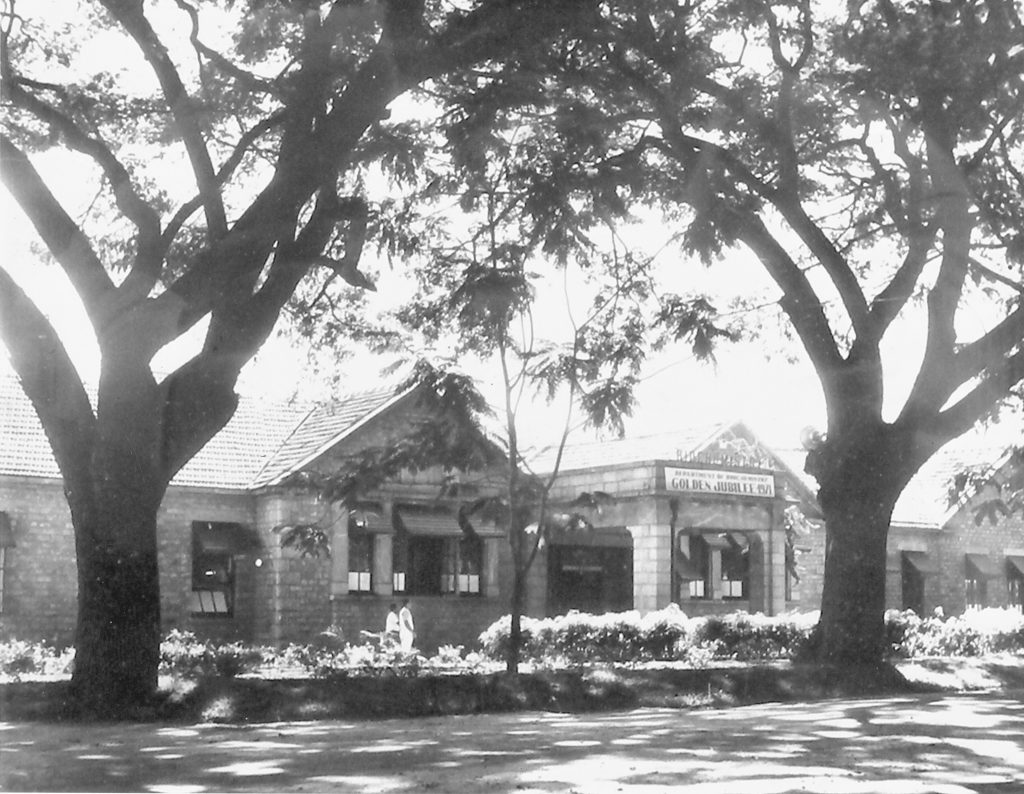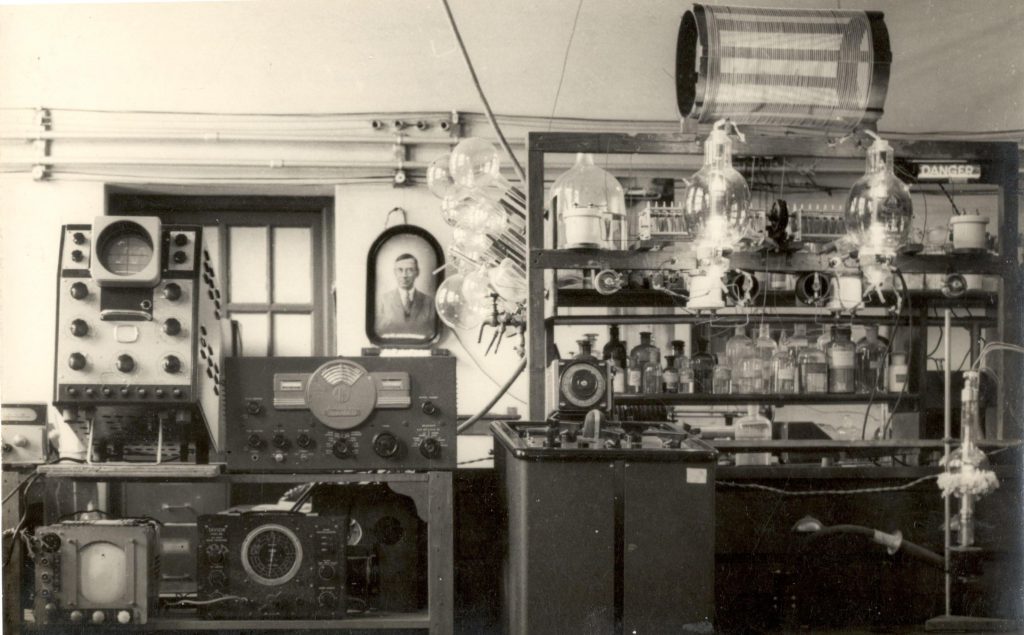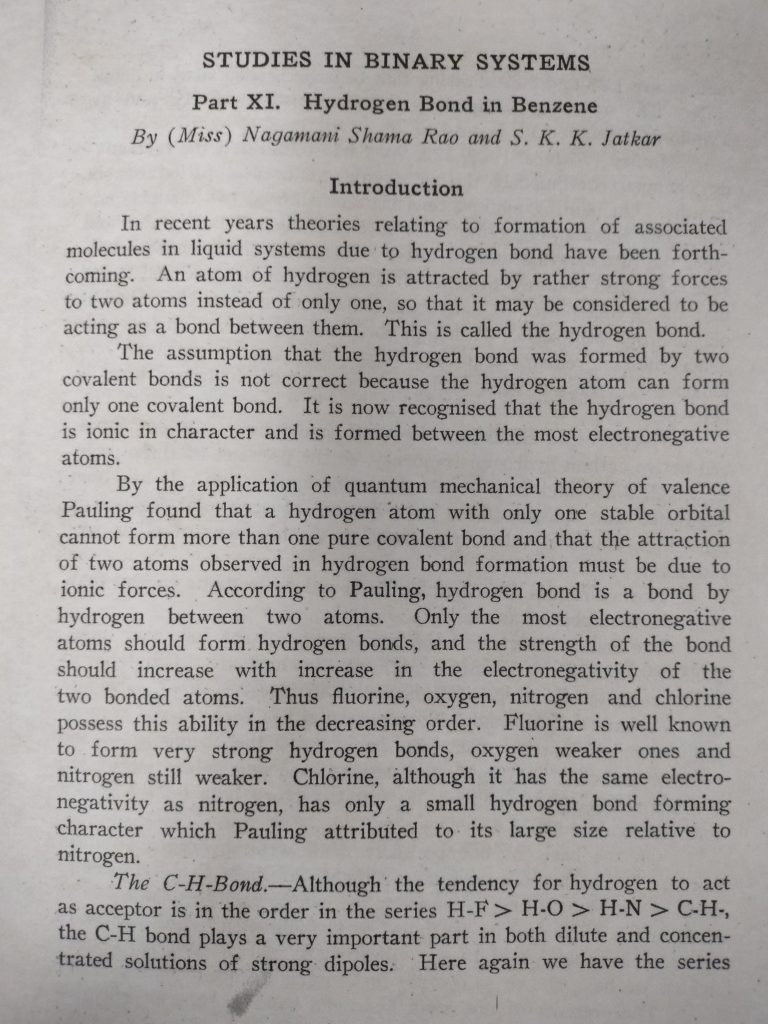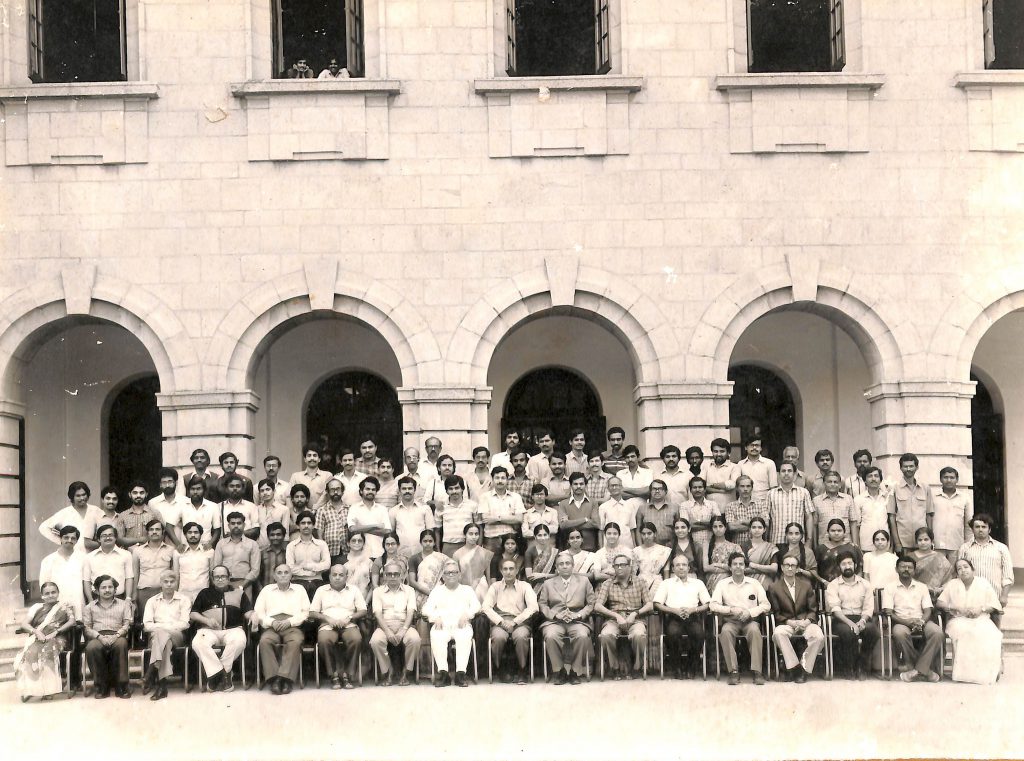Why the oldest department in IISc continues to be relevant

As one goes down the canopy-covered Tala Marg in IISc, there stands a building tucked unobtrusively on the right side. The exposed stone bricks, sharp features, and small windows harken back to a time when robustness and utility were qualities that were paramount. Even the letters that read Department of Inorganic and Physical Chemistry (IPC) appear devoid of the flair we see in today’s world. It stands to reason.
For over a hundred years, the building was home to the first department in the Institute – alongside the Department of Electrical Technology. IPC was initially in the Main Building until it moved here just a few years after IISc was established in 1909.
Over the years, the Department, then called the Department of General and Applied Chemistry, has grown and evolved. A couple of years ago, it moved into a newly built glass-tinted, tall-pillared, gargantuan building with well-manicured walkways, in keeping with the growth of the Department and the aesthetics of the 21st century. The new building also has other departments that fall under the Division of Chemical Sciences.
When IISc started in the early 20th century, chemistry was the science in vogue, leading the charge as the world went through tectonic changes. There was industrialisation, catalysed by developments in chemistry, which aimed at helping people live better lives. In a cruel paradox, chemistry also fuelled wars, including World War I. The deadly dynamite was created by the Swedish chemist Alfred Nobel, who – in penance – bequeathed his vast fortunes to establish the Nobel Prize. Chemistry ruled the roost.
When IISc started in the early 20th century, chemistry was the science in vogue, leading the charge as the world went through tectonic changes
It was, therefore, no surprise that chemistry was the most important subject to be studied even at IISc. And that its first Director was Morris Travers, a chemist of some repute following his work on discovering noble gases alongside Nobel Laureate William Ramsey. It even earned him the nickname Rare Gas Travers.
“It was a chemist who planned and executed the [building of the] institution,” AR Vasudeva Murthy, who chaired IPC from 1973-77, once said while recollecting the history of the Institute in an audio recording. “It was chemists who thought of using Indian mineral and forest resources for industrial purposes. To transform natural resources for the benefit of people was a big thing.”

Guided by India’s most well-known engineer, M Visvesvaraya – then also the Dewan of Mysore and a member of IISc’s Council – the Institute also helped advance industrialisation in India. New chemistry departments came up – the Department of Organic Chemistry in 1911 and the Department of Biochemistry in 1921.
The drive to make an impact on society even led to many commercial activities. Among the earliest large-scale industrial projects was research on sandalwood, led by Sosale Garalapury Sastry. In 1916, it resulted in the production of sandal oil and soap, both of which were mass-produced by the government and soon became emblematic of Mysore State and eventually Karnataka. There was also research on oils, dyes, and fermentation, among others.
In the 1920s and 1930s, with the advent of atomic physics and quantum mechanics, physics became the darling of the scientific world. In IISc, this period coincided with the hiring of CV Raman as its first Indian Director. When he joined IISc in 1933, he set up the Department of Physics the same year and also became its head. During Raman’s time, there was a perception that he favoured the Physics Department over other departments, according to BV Subbarayappa in his book, In Pursuit of Excellence: A History of the Indian Institute of Science. It also did not help Raman’s cause that he lacked administrative tact, Subbarayappa writes.
During Raman’s time, there was a perception that he favoured the Physics Department over other departments, according to BV Subbarayappa
Following Raman’s acrimonious tenure and eventual resignation in 1937 – he continued to lead the Physics Department until 1948 – JC Ghosh became the Director in 1939 (IISc had an Acting Director for a couple of years). Though a chemist himself, Ghosh’s tenure saw many engineering departments come up. During this period, IISc was also mandated to participate in projects to help Britain’s World War II efforts.
With IISc expanding and moving towards nation-building projects in the years immediately before and after independence, IPC, however, kept its eyes on the ball and continued to produce quality fundamental and applied research. And this has carried on to this day. IPC’s contributions are exemplified by multiple innovations.
Powering forward
One such innovation was the development of batteries by electrochemist S Sathyanarayana. Battery Sathyanarayana, as he was sometimes referred to, joined IISc at the insistence of AKN Reddy, Professor at IPC, who was building a strong contingent of electrochemists in the IPC department.
Reddy and Sathyanarayana started developing magnesium-manganese dioxide batteries as part of a project initiated by Bharat Electronics Limited with the latter continuing his efforts to the production level. India was only one of two countries – the other being Israel – to manufacture them then.
Sathyanarayana would also go on to be a driving force in the development of nickel-cadmium batteries to help with India’s space programme in the 1970s. The Vikram Sarabhai Space Centre (VSSC) started with lead acid batteries, a Soviet technology, but these were heavy and required a lot of space.
“The requirement was to develop sealed nickel-cadmium batteries, with Sathyanarayana as the consultant,” recollects N Munichandraiah, Emeritus Professor at IPC. “The batteries had to meet certain mechanical and physical requirements because they were going to go to space in satellites. Two or three satellites operated with nickel-cadmium batteries developed by VSSC in consultation with Sathyanarayana.”
When the space application demanded higher energy density batteries, nickel-hydrogen batteries and lithium-ion batteries were developed. IPC played a key role in the development and evolution of batteries from the 1970s onwards and even segued into the development of supercapacitors and fuel cells.
But all along, IPC never lost sight of its commitment to basic research as well. In some instances, it was ahead of the curve. Case in point: IPC’s research on hydrogen bonds. When the Journal of the Indian Institute of Science celebrated its centenary in 2014, it brought out a special edition with the most important discoveries reported in it over a hundred years. One of them was a paper from 1943 about hydrogen bonds.

The paper, titled Hydrogen Bond in Benzene, was originally published by Nagamani Shama Rao, one of IISc’s earliest women researchers, and SKK Jatkar from IPC, in which they pointed out that methane could really be bound by hydrogen bonds.
E Arunan, IPC’s Chair, explains its significance: “At that time, people thought hydrogen bonded [only] to highly electronegative elements like oxygen, nitrogen, and fluorine can be involved in hydrogen bonding. However, there was some evidence that hydrogen sulphide or methane could [also] form hydrogen bonds. [At that time], it was dismissed by powerful people, including Linus Pauling, who was probably the most influential chemist of the 20th century.”
But all along IPC never lost sight of its commitment to basic research as well. In some instances, it was ahead of the curve
“In the 1980s and 90s, chemists argued whether methane can form hydrogen bond or not. The paper was forgotten about,” Arunan adds. Studies on hydrogen bonds have come a long way since then and the Institute’s tryst with the bond has continued. In 2011, Arunan led an International Union of Pure and Applied Chemistry (IUPAC) task group to determine a new definition of hydrogen bonding.
On a side note, Jatkar’s work here also gives a glimpse of his excellence as a researcher and why Raman, during his tenure as Director, tried to transfer him – along with MA Govinda Rau – to the Physics Department. Jatkar, however, was not keen on moving, particularly since it would involve shifting his equipment from IPC to the Physics Department.
Missed opportunities
Yet another innovation that came out of IPC was in 1988 when a procedure called Solution Combustion Synthesis (SCS) was discovered accidentally by KC Patil, Professor in the Department. In 1987, Patil published a paper titled A low temperature path to ultrafine ferrites in the American Ceramic Society Bulletin. A year later, SCS of nanocrystalline oxide materials was first published in Material Letters. It resulted in the synthesis of what were then just called ultra-fine particles. While the first paper dealt with synthesis in which the precursors were solid, the latter was a reaction in an aqueous medium. SCS has been standardised and the materials having interesting magnetic, dielectric, catalytic and optical properties are useful in making nano devices for specific applications.
Today, these particles are well known as nanoparticles and have a wide range of applications The method, not patented, had many advantages in terms of cost, time, and equipment, and was then used by many countries to accelerate their work on nanoparticles. “The application of this is in so many things. We did science. Today it is being used, I don’t know [by] who and for what, because I did not take a patent,” says Patil. India, it would seem, missed the nanoparticle boat. The same can be said of a silicon project led by Murthy in the 1970s. This too was a project way ahead of its time. But Murthy perhaps realised that we would soon be living in a world run by silicon microchips.

Murthy and his colleagues at IISc even provided the expertise for a silicon factory built by Mettur Chemicals at Mettur in Salem District. The factory supplied silicon wafers to many industries for a time before shutting down. It’s impact but a pale shadow of what it could have been.
“Now, Chinese Taipei makes almost all the silicon for the world. It didn’t succeed here even though it all started here,” says Arunan.
Both the silicon initiative and nanoparticle discovery reveal that though IPC researchers have been doing cutting-edge research through the decades, they have not always been equipped to commercialise their work.
Giving Back
AKN Reddy chose a different path to give back to society.
“After almost two decades in the field of electrochemistry, I felt my own work was largely irrelevant to India’s poor. I felt I should reorient my efforts towards technologies for rural development,” he once explained in a 2018 article by Munichandraiah in IPC’s Elixir magazine. In 1974, Reddy left IPC to establish ASTRA (Application of Science and Technology for Rural Areas) at IISc itself, which has since been renamed the Centre for Sustainable Technologies.
IPC has also contributed to chemistry in other ways. The Department was instrumental in helping educate and train students, scholars and future leaders. As Murthy points out, “Who else was there to teach?” This is a role they continue to play to this day, especially with IISc’s four-year undergraduate programme which offers a major in Chemistry. Arunan was a vocal supporter of IISc’s decision to start the programme.
“Chemistry is the central science,” says Arunan matter-of-factly
As science branched across different channels, becoming increasingly interdisciplinary in nature, IPC researchers too ventured into newer territories. And perhaps there lies the answer to a curious question. A century ago, chemistry was the branch of science in vogue before physics knocked it off its pedestal. One can argue that chemistry lacked fashionable names like Albert Einstein and Richard Feynman, who crossed into popular culture. Maybe even sitcoms like The Big Bang Theory and films like Interstellar played a role in making physics “cool”. Popular culture embracing physics could be one of the reasons for chemistry losing its status as the pre-eminent science. But another is that chemistry seems to have just amalgamated into several interdisciplinary streams.
However, chemistry may once again be getting the attention it deserves and may no longer remain the poorer cousin of physics. For instance, the 2023 Nobel Prize in Chemistry was awarded to Moungi G Bawendi, Louis E Brus, and Alexei I Ekimov for the discovery and synthesis of quantum dots. While Bawendi and Brus are chemists, Ekimov is a physicist.
“Chemistry is the central science,” Arunan says matter-of-factly. While researchers from other fields might quibble with the sweeping nature of the statement, prudence would suggest that chemistry, the study of matter, would continue to foster fundamental discoveries and make our world a better place. And given their track record, IPC and other chemistry departments at IISc will play their part.




